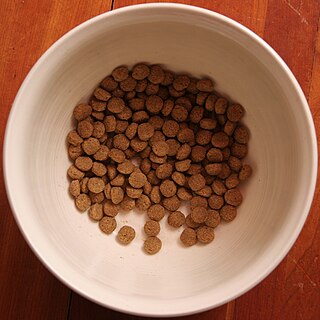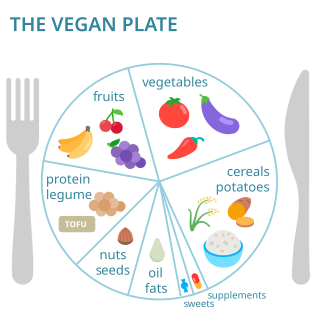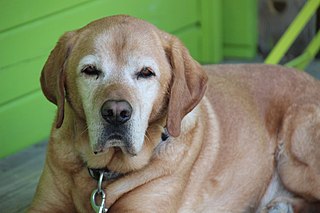Related Research Articles
Omega−3 fatty acids, also called omega−3 oils, ω−3 fatty acids or n−3 fatty acids, are polyunsaturated fatty acids (PUFAs) characterized by the presence of a double bond three atoms away from the terminal methyl group in their chemical structure. They are widely distributed in nature, being important constituents of animal lipid metabolism, and they play an important role in the human diet and in human physiology. The three types of omega−3 fatty acids involved in human physiology are α-linolenic acid (ALA), eicosapentaenoic acid (EPA) and docosahexaenoic acid (DHA). ALA can be found in plants, while DHA and EPA are found in algae and fish. Marine algae and phytoplankton are primary sources of omega−3 fatty acids. DHA and EPA accumulate in fish that eat these algae. Common sources of plant oils containing ALA include walnuts, edible seeds, and flaxseeds as well as hempseed oil, while sources of EPA and DHA include fish and fish oils, and algae oil.

Taurine, or 2-aminoethanesulfonic acid, is a non-proteinogenic naturally occurred amino sulfonic acid that is widely distributed in animal tissues. It is a major constituent of bile and can be found in the large intestine, and accounts for up to 0.1% of total human body weight.

A kitten is a juvenile cat. After being born, kittens display primary altriciality and are fully dependent on their mothers for survival. They normally do not open their eyes for seven to ten days. After about two weeks, kittens develop quickly and begin to explore the world outside their nest. After a further three to four weeks, they begin to eat solid food and grow baby teeth. Domestic kittens are highly social animals and usually enjoy human companionship.
A nutrient is a substance used by an organism to survive, grow and reproduce. The requirement for dietary nutrient intake applies to animals, plants, fungi and protists. Nutrients can be incorporated into cells for metabolic purposes or excreted by cells to create non-cellular structures such as hair, scales, feathers, or exoskeletons. Some nutrients can be metabolically converted into smaller molecules in the process of releasing energy such as for carbohydrates, lipids, proteins and fermentation products leading to end-products of water and carbon dioxide. All organisms require water. Essential nutrients for animals are the energy sources, some of the amino acids that are combined to create proteins, a subset of fatty acids, vitamins and certain minerals. Plants require more diverse minerals absorbed through roots, plus carbon dioxide and oxygen absorbed through leaves. Fungi live on dead or living organic matter and meet nutrient needs from their host.

A dietary supplement is a manufactured product intended to supplement a person's diet by taking a pill, capsule, tablet, powder, or liquid. A supplement can provide nutrients either extracted from food sources, or that are synthetic. The classes of nutrient compounds in supplements include vitamins, minerals, fiber, fatty acids, and amino acids. Dietary supplements can also contain substances that have not been confirmed as being essential to life, and so are not nutrients per se, but are marketed as having a beneficial biological effect, such as plant pigments or polyphenols. Animals can also be a source of supplement ingredients, such as collagen from chickens or fish for example. These are also sold individually and in combination, and may be combined with nutrient ingredients. The European Commission has also established harmonized rules to help insure that food supplements are safe and appropriately labeled.

Choline ( KOH-leen) is an essential nutrient for humans and many other animals, which was formerly classified as a B vitamin (vitamin B4). It is a structural part of phospholipids and a methyl donor in metabolic one-carbon chemistry. The compound is related to trimethylglycine in the latter respect. It is a cation with the chemical formula [(CH3)3NCH2CH2OH]+. Choline forms various salts, for example choline chloride and choline bitartrate.

Dog food is specifically formulated and intended for consumption by dogs and other related canines. Dogs are considered to be omnivores with a carnivorous bias. They have the sharp, pointed teeth and shorter gastrointestinal tracts of carnivores, better suited for the consumption of meat than of vegetable substances, yet also have ten genes that are responsible for starch and glucose digestion, as well as the ability to produce amylase, an enzyme that functions to break down carbohydrates into simple sugars – something that obligate carnivores like cats lack. Dogs evolved the ability living alongside humans in agricultural societies, as they managed on scrap leftovers and excrement from humans.
B vitamins are a class of water-soluble vitamins that play important roles in cell metabolism and synthesis of red blood cells. They are a chemically diverse class of compounds.

Nootropics, colloquially brain supplements, smart drugs and cognitive enhancers, are natural, semisynthetic or synthetic compounds which purportedly improve cognitive functions, such as executive functions, attention or memory.

Cat food is food specifically formulated and designed for consumption by cats. As obligate carnivores, cats have specific requirements for their dietary nutrients, namely nutrients found only in meat or synthesized, such as taurine and Vitamin A. Certain nutrients, including many vitamins and amino acids, are degraded by the temperatures, pressures and chemical treatments used during manufacture, and hence must be added after manufacture to avoid nutritional deficiency. Cat food is typically sold as dry kibble, or as wet food in cans and pouches.
Raw feeding is the practice of feeding domestic dogs, cats, and other animals a diet consisting primarily of uncooked meat, edible bones, and organs. The ingredients used to formulate raw diets vary. Some pet owners choose to make home-made raw diets to feed their animals but commercial raw diets are also available.

Docosahexaenoic acid (DHA) is an omega-3 fatty acid that is an important component of the human brain, cerebral cortex, skin, and retina. It is given the fatty acid notation 22:6(n-3). It can be synthesized from alpha-linolenic acid or obtained directly from maternal milk, fatty fish, fish oil, or algae oil. The consumption of DHA contributes to numerous physiological benefits, including cognition. As a component of neuronal membranes, the function of DHA is to support neuronal conduction and to allow the optimal functioning of neuronal membrane proteins.
Cat intelligence is the capacity of the domesticated cat to solve problems and adapt to its environment. Research has shown that feline intelligence includes the ability to acquire new behavior that applies knowledge to new situations, communicating needs and desires within a social group and responding to training cues.

Nutritional neuroscience is the scientific discipline that studies the effects various components of the diet such as minerals, vitamins, protein, carbohydrates, fats, dietary supplements, synthetic hormones, and food additives have on neurochemistry, neurobiology, behavior, and cognition.

Vegan nutrition refers to the nutritional and human health aspects of vegan diets. A well-planned vegan diet is suitable to meet all recommendations for nutrients in every stage of human life. Vegan diets tend to be higher in dietary fiber, magnesium, folic acid, vitamin C, vitamin E, and phytochemicals; and lower in calories, saturated fat, iron, cholesterol, long-chain omega-3 fatty acids, vitamin D, calcium, zinc, and vitamin B12.
Relatively speaking, the brain consumes an immense amount of energy in comparison to the rest of the body. The mechanisms involved in the transfer of energy from foods to neurons are likely to be fundamental to the control of brain function. Human bodily processes, including the brain, all require both macronutrients, as well as micronutrients.

The developmental life stage of dogs requires a specific intake of nutrients to ensure proper growth and development and to meet energy requirements. Despite the fact that puppies have different nutritional requirements compared to their adult counterparts, of the 652 breeders surveyed in the United States and Canada in 2012, 8.7% report feeding puppies commercial diets not intended for the developmental life stage of canines. Large and small dog breeds have even more specific nutrient requirements during growth, such as adjusted calcium to phosphorus ratio, and as such should receive a breed specific growth formula. Feeding diets formulated by a nutritionist for specific breeds and life stage differences in nutrient requirements ensures a growing puppy will receive the proper nutrition associated with appropriate skeletal, neurological and immune development. This includes nutrients such as protein, fibre, essential fatty acids, calcium and vitamin E. It is therefore important to feed puppies a diet that meets the minimum and/or maximum requirements established by the National Research Council.

A senior cat diet is generally considered to be a diet for cats that are mature, senior, or geriatric. Nutritional considerations arise when choosing an appropriate diet for a healthy senior cat. Dietary management of many conditions becomes more important in senior cats because changes in their physiology and metabolism may alter how their system responds to medications and treatments.

Senior dog food diets are pet foods that are catered toward the senior or mature pet population. The senior dog population consists of dogs that are over the age of seven for most dog breeds, though in general large and giant breed dogs tend to reach this life stage earlier when compared to smaller breed dogs. Senior dog foods contain nutrients and characteristics that are used to improve the health of the aging dog. Aging in dogs causes many changes to occur physiologically that will require a change in nutrient composition of their diet.

As in the human practice of veganism, vegan dog foods are those formulated with the exclusion of ingredients that contain or were processed with any part of an animal, or any animal byproduct. Vegan dog food may incorporate the use of fruits, vegetables, cereals, legumes including soya, nuts, vegetable oils, as well as any other non-animal based foods.
References
- ↑ Bellows, J.; Center, S.; Daristotle, L.; Estrada, A.H.; Flickinger, E.A.; Horwitz, D.F.; Lascelles, B.D.X.; Lepine, A.; Perea, S.; Scherk, M.; Shoveller, A.K. (2016). "Evaluating Aging in Cats: How to determine what is healthy and what is disease". J Feline Med Surg. 18 (7): 551–570. doi:10.1177/1098612x16649525. PMC 10816674 . PMID 27370393. S2CID 22855661.
- 1 2 3 Gunn-Moore, D.; Moffat, K.; Christie, L-A.; Head, E. (2007). "Cognitive dysfunction and the neurobiology of ageing in cats". J Small Anim Pract. 48 (10): 546–553. doi:10.1111/j.1748-5827.2007.00386.x. PMID 17617164.
- ↑ Pittari, J.; Rodan, I.; Beekman, G.; Gunn-Moore, D.; Polzin, D.; Taboada, J.; Tuzio, H.; Zoran, D. (2009). "American Associate of Feline Practitioners: Senior Care Guidelines". J Feline Med Surg. 11 (9): 763–778. doi: 10.1016/j.jfms.2009.07.011 . PMC 11135487 . PMID 19712895.
- 1 2 3 Landsberg, G.; Denenberg, S.; Araujo, J. (2010). "Cognitive Dysfunction In Cats: A syndrome we used to dismiss as 'old age'". J Feline Med Surg. 12 (11): 837–848. doi:10.1016/j.jfms.2010.09.004. PMC 11220932 . PMID 20974401. S2CID 27693875.
- 1 2 3 4 Covington, MB. (2004). "Omega-3 Fatty Acids". American Family Physician. 70 (1): 133–140. PMID 15259529.
- 1 2 3 4 Pawlosky RJ., Denkins Y., Ward G. & Salem N. Jr. (1997). "Retinal and brain accretion of long-chain polyunsaturated fatty acids in developing felines: the effects of corn oil-based maternal diets". The American Journal of Clinical Nutrition. 65 (2): 465–72. doi: 10.1093/ajcn/65.2.465 . PMID 9022532.
{{cite journal}}: CS1 maint: multiple names: authors list (link) - 1 2 3 Ximenes da Silva A., Lavialle F., Gendrot G., Guesnet P., Alessandri, JM. and Lavialle M (2002). "Glucose transport and utilization are altered in the brain of rats deficient in (n-3) polyunsaturated fatty acids". Journal of Neurochemistry. 81 (6): 1328–37. doi: 10.1046/j.1471-4159.2002.00932.x . PMID 12068080.
{{cite journal}}: CS1 maint: multiple names: authors list (link) - 1 2 3 4 Biagi G., Moedenti A. and Cocchi M. (2004). "The role of dietary omega-3 and omega-6 essential fatty acids in the nutrition of dogs and cat: A review". Progress in Nutrition. 6 (2): 1–13.
- 1 2 3 4 5 6 7 8 9 10 11 12 13 14 15 16 17 18 AAFCO (2014) AAFCO Dog and Cat Food Nutrient Profiles. Pet Food Report: Proposed Revisions Edited per Comments 2014 Official Publication. Retrieved November 24th 2017 from: http://www.aafco.org/Portals/0/SiteContent/Regulatory/Committees/Pet-Food/Reports/Pet_Food_Report_2013_Midyear Proposed_Revisions_to_AAFCO_Nutrient_Profiles.pdf
- 1 2 3 Bauer EB. (2006). "Metabolic basis for the essential nature of fatty acids and the unique dietary fatty acid requirement of cats". Journal of the American Veterinary Medical Association. 229 (11): 1729–32. doi: 10.2460/javma.229.11.1729 . PMID 17144816.
- ↑ Coutreras MA., Greiner RS., Chang MC., Myers CS., Salem N JR. and Rapoport SI (2000). "Nutritional deprivation of alpha-linolenic acid decreases but does not abolish turnover and availability of unacylated docosahexaenoic acid and docosahexaenoyl-CoA in rat brain". Journal of Neurochemistry. 75 (6): 2392–400. doi: 10.1046/j.1471-4159.2000.0752392.x . PMID 11080190.
{{cite journal}}: CS1 maint: multiple names: authors list (link) - 1 2 Sturman JA., Lu P., Xu Y. and Imaki H. ( (1994). "Feline Maternal Taurine Deficiency: Effects on Visual Cortex of the Offspring. A Morphometric and Immunohistochemical Study". Taurine in Health and Disease. Advances in Experimental Medicine and Biology. Vol. 359. pp. 369–84. doi:10.1007/978-1-4899-1471-2_38. ISBN 978-1-4899-1473-6. PMID 7887277.
{{cite book}}: CS1 maint: multiple names: authors list (link) - ↑ Sturman JA., Rassin DK. and Gaull GE. (1977). "Taurine in development". Life Sciences. 21 (1): 1–21. doi:10.1016/0024-3205(77)90420-9. PMID 329037.
- 1 2 3 4 5 6 7 8 9 Kennedy, D.O. (2016) B Vitamins and the Brain: Mechanisms, Dose and Efficacy – A Review. Nutrients. 8(2), 68-97.
- ↑ Irle, E.; Markowitsch, H.J. (1982). "Thiamine Deficiency in the Cat Leads to Severe Learning Deficits and to Widespread Neuroanatomical Damage". Exp Brain Res. 48 (2): 199–208. doi:10.1007/bf00237215. PMID 7173357. S2CID 22548276.
- ↑ Ashoori, M. and Saedisomeolia, A. (2014) Riboflavin (vitamin B2) and oxidative stress: a review. Br J Nutr. 111, 1985-1991.
- 1 2 3 4 Baybutt, Richard C.; Molteni, Agostino (2007). Vitamin A. Vitamins & Hormones. Vol. 75. pp. 385–401. doi:10.1016/s0083-6729(06)75014-2. ISBN 9780127098753. PMID 17368323.
- 1 2 3 4 5 6 Raila, Jens; Mathews, Una; Schweigert, Florian J. (2001). "Plasma transport and tissue distribution of β-carotene, vitamin A and retinol-binding protein in domestic cats". Comparative Biochemistry and Physiology Part A: Molecular & Integrative Physiology. 130 (4): 849–856. doi:10.1016/s1095-6433(01)00443-3. PMID 11691620.
- ↑ "Vitamin E".
- 1 2 Gemma, Carmelina (2007). Brain Aging: Models, Methods, and Mechanisms. Boca Raton (FL): CRC Press/Taylor & Francis. pp. Chapter 15.
- 1 2 Shawn., Messonnier (2012). Nutritional supplements for the veterinary practice : a pocket guide. American Animal Hospital Association. Lakewood, Colo.: AAHA Press. ISBN 9781583261743. OCLC 794670587.
- ↑ Shawn., Messonnier (2001). Natural health bible for dogs & cats : your A-Z guide to over 200 conditions, herbs, vitamins, and supplements (1st ed.). Roseville, Calif.: Prima. ISBN 9780761526735. OCLC 45320627.
- ↑ Dodson, W. L.; Sachan, D. S. (June 1996). "Choline supplementation reduces urinary carnitine excretion in humans". The American Journal of Clinical Nutrition. 63 (6): 904–910. doi: 10.1093/ajcn/63.6.904 . ISSN 0002-9165. PMID 8644685.
- ↑ Daily, James W; Hongu, Nobuko; Mynatt, Randall L; Sachan, Dileep S (1998-08-01). "Choline supplementation increases tissue concentrations of carnitine and lowers body fat in guinea pigs". Journal of Nutritional Biochemistry. 9 (8): 464–470. doi:10.1016/S0955-2863(98)00044-8. ISSN 0955-2863.
- ↑ Carter, A. L.; Frenkel, R. (November 1978). "The relationship of choline and carnitine in the choline deficient rat". The Journal of Nutrition. 108 (11): 1748–1754. doi:10.1093/jn/108.11.1748. ISSN 0022-3166. PMID 712418.
- ↑ Pekala, Jolanta; Patkowska-Sokoła, Bozena; Bodkowski, Robert; Jamroz, Dorota; Nowakowski, Piotr; Lochyński, Stanisław; Librowski, Tadeusz (September 2011). "L-carnitine--metabolic functions and meaning in humans life". Current Drug Metabolism. 12 (7): 667–678. doi:10.2174/138920011796504536. ISSN 1875-5453. PMID 21561431.
- 1 2 Tanaka, Yasukazu; Sasaki, Rorie; Fukui, Fumiko; Waki, Hatsue; Kawabata, Terue; Okazaki, Mitsuyo; Hasegawa, Kyoko; Ando, Susumu (April 2004). "Acetyl-L-carnitine supplementation restores decreased tissue carnitine levels and impaired lipid metabolism in aged rats". Journal of Lipid Research. 45 (4): 729–735. doi: 10.1194/jlr.M300425-JLR200 . ISSN 0022-2275. PMID 14703509.
- 1 2 Zeisel, Steven H.; Mar, Mei-Heng; Howe, Juliette C.; Holden, Joanne M. (May 2003). "Concentrations of choline-containing compounds and betaine in common foods". The Journal of Nutrition. 133 (5): 1302–1307. doi: 10.1093/jn/133.5.1302 . ISSN 0022-3166. PMID 12730414.
- ↑ Tainer, J. A.; Getzoff, E. D.; Richardson, J. S.; Richardson, D. C. (Nov 17–23, 1983). "Structure and mechanism of copper, zinc superoxide dismutase". Nature. 306 (5940): 284–287. Bibcode:1983Natur.306..284T. doi:10.1038/306284a0. ISSN 0028-0836. PMID 6316150. S2CID 4266810.
- ↑ Webb, Craig B.; Lehman, Tracy L.; McCord, Kelly W. (October 2008). "Effects of an oral superoxide dismutase enzyme supplementation on indices of oxidative stress, proviral load, and CD4:CD8 ratios in asymptomatic FIV-infected cats". Journal of Feline Medicine and Surgery. 10 (5): 423–430. doi:10.1016/j.jfms.2008.01.008. ISSN 1098-612X. PMC 11271243 . PMID 18387839. S2CID 72560.
- ↑ Christianson, D. W. (1997). "Structural chemistry and biology of manganese metalloenzymes". Progress in Biophysics and Molecular Biology. 67 (2–3): 217–252. doi: 10.1016/s0079-6107(97)88477-5 . ISSN 0079-6107. PMID 9446936.
- ↑ Bhabak, Krishna P.; Mugesh, Govindasamy (2010-11-16). "Functional Mimics of Glutathione Peroxidase: Bioinspired Synthetic Antioxidants". Accounts of Chemical Research. 43 (11): 1408–1419. doi:10.1021/ar100059g. ISSN 0001-4842. PMID 20690615.
- 1 2 Kerksick, Chad; Willoughby, Darryn (2005-12-09). "The antioxidant role of glutathione and N-acetyl-cysteine supplements and exercise-induced oxidative stress". Journal of the International Society of Sports Nutrition. 2 (2): 38–44. doi: 10.1186/1550-2783-2-2-38 . ISSN 1550-2783. PMC 2129149 . PMID 18500954.
- ↑ Belhorn, R.W. "Feline central retinal degeneration". Invest Ophthalmol Vis Sci. 13: 608–616.
- 1 2 Smith, Marty (Fall 2017). "Progressive Retinal Atrophy/Degeneration in Cats (PRA, PRD)". peteducation.com. Archived from the original on 2002-02-15. Retrieved 2017-12-02.
- ↑ Lenox . 1(1), 1-5., C. (Fall 2017). "Metabolic bone disease ad central retinal degeneration in a kitten due to nutritional inadequacy of an all-meat raw diet". J Feline Med Surg. 1 (1): 205511691557968. doi:10.1177/2055116915579682. PMC 5362880 . PMID 28491346.
{{cite journal}}: CS1 maint: numeric names: authors list (link) - ↑ Hayes, K. C.; Carey, Richard E.; Schmidt, Susan Y. (1975). "Retinal Degeneration Associated with Taurine Deficiency in the Cat". Science. 188 (4191): 949–951. Bibcode:1975Sci...188..949H. doi:10.1126/science.1138364. PMID 1138364.
- 1 2 Gunn-Moore, Danièlle A. (2011). "Cognitive Dysfunction in Cats: Clinical Assessment and Management". Topics in Companion Animal Medicine. 26 (1): 17–24. doi:10.1053/j.tcam.2011.01.005. PMID 21435622.
- ↑ Chambers, James K.; Tokuda, Takahiko; Uchida, Kazuyuki; Ishii, Ryotaro; Tatebe, Harutsugu; Takahashi, Erika; Tomiyama, Takami; Une, Yumi; Nakayama, Hiroyuki (2015-12-10). "The domestic cat as a natural animal model of Alzheimer's disease". Acta Neuropathologica Communications. 3: 78. doi: 10.1186/s40478-015-0258-3 . ISSN 2051-5960. PMC 4674944 . PMID 26651821.
- ↑ Landsberg, Gary M.; Nichol, Jeff; Araujo, Joseph A. (2012). "Cognitive Dysfunction Syndrome". Veterinary Clinics of North America: Small Animal Practice. 42 (4): 749–68, vii. doi:10.1016/j.cvsm.2012.04.003. PMID 22720812.
- 1 2 Landsberg, Gary; Araujo, Joseph A. (2005). "Behavior Problems in Geriatric Pets". Veterinary Clinics of North America: Small Animal Practice. 35 (3): 675–698. doi:10.1016/j.cvsm.2004.12.008. PMID 15833565.
- ↑ Laflamme, Dottie; Gunn-Moore, Danièlle (2014). "Nutrition of Aging Cats". Veterinary Clinics of North America: Small Animal Practice. 44 (4): 761–774. doi:10.1016/j.cvsm.2014.03.001. PMID 24951345.